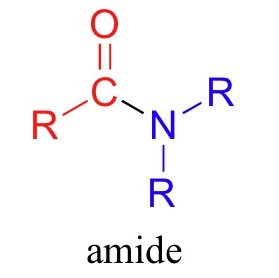The Case of the Substitute Radical
While I had big plans for this post, time and work have intervened. I will skip the chemistry lesson and tell you what you need to know. This is the upshot from the CAFC decision in Chemtall.
The classification issue boils down to whether acrylamide tertiary butyl sulfonic acid ("ATBS") is an amide or a derivative of an amide. An amide is a class of chemicals that is defined by a carbon atom double bonded to an oxygen atom and to a nitrogen atom. The carbon atom is bonded to a radical designated R1. The nitrogen atom is bonded to two radicals designated R2 and R3. That makes for molecule that looks like this:
The issue here is the composition one of the radicals. Is the product still an amide if one of the radicals is bonded to the sulfur compound SO3H? If so, the product is classifiable in 2924.19.11 as an amide (3.7%). If not, it is classifiable in 2924.19.80 (6.5%).
Here's the answer: most secondary chemistry resources define amides as having only hydrogen or hydrocarbyls bonded to the nitrogen. The sulfur compound is neither. Furthermore, Chemtall's expert testimony that an amide can contain a substituted radical was not, according to the Court, persuasive. The non-binding Explanatory Notes were not clear on this point. Thus, Chemtall failed to convince the Court that the CIT decision was incorrect. The Federal Circuit affirmed, leaving the classification as 2924.19.80.
Two interesting asides appear in the decision, both of which reinforce fundamental points of tariff classification law. The first is that a dictionary definition is most persuasive if it appears close in time to the promulgation of the statutory language. In this case, the 1986 edition of two dictionaries were favored because they were closest in time before the 1989 enactment of the HTSUS. Second, the two-digit statistical suffix forming the 9th and 10th digits of the tariff item (and corresponding language) are not relevant to the interpretation of the tariff. This decision will probably be cited for those two propositions more than anything else.
Yes, the title of this post is intended to sound like a Sherlock Holmes mystery. If I did not have a real job, this post would follow suit.
The classification issue boils down to whether acrylamide tertiary butyl sulfonic acid ("ATBS") is an amide or a derivative of an amide. An amide is a class of chemicals that is defined by a carbon atom double bonded to an oxygen atom and to a nitrogen atom. The carbon atom is bonded to a radical designated R1. The nitrogen atom is bonded to two radicals designated R2 and R3. That makes for molecule that looks like this:
The issue here is the composition one of the radicals. Is the product still an amide if one of the radicals is bonded to the sulfur compound SO3H? If so, the product is classifiable in 2924.19.11 as an amide (3.7%). If not, it is classifiable in 2924.19.80 (6.5%).
Here's the answer: most secondary chemistry resources define amides as having only hydrogen or hydrocarbyls bonded to the nitrogen. The sulfur compound is neither. Furthermore, Chemtall's expert testimony that an amide can contain a substituted radical was not, according to the Court, persuasive. The non-binding Explanatory Notes were not clear on this point. Thus, Chemtall failed to convince the Court that the CIT decision was incorrect. The Federal Circuit affirmed, leaving the classification as 2924.19.80.
Two interesting asides appear in the decision, both of which reinforce fundamental points of tariff classification law. The first is that a dictionary definition is most persuasive if it appears close in time to the promulgation of the statutory language. In this case, the 1986 edition of two dictionaries were favored because they were closest in time before the 1989 enactment of the HTSUS. Second, the two-digit statistical suffix forming the 9th and 10th digits of the tariff item (and corresponding language) are not relevant to the interpretation of the tariff. This decision will probably be cited for those two propositions more than anything else.
Yes, the title of this post is intended to sound like a Sherlock Holmes mystery. If I did not have a real job, this post would follow suit.



Comments